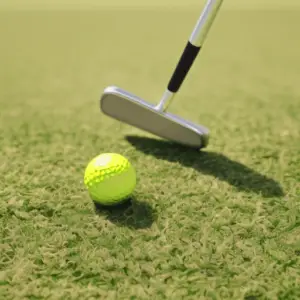Last Updated on October 17, 2023
Golf is a challenging and rewarding sport that requires patience, focus, and precision. Unfortunately for many golfers, overswinging can be an issue that hinders their performance on the course. If you find yourself struggling with this common problem, don’t worry; there are simple steps you can take to help get it under control. This article will delve into how to stop overswinging in golf so that you can begin improving your game right away.
Definition of Overswinging
Overswinging is a common problem for golfers, defined as taking too large of a swing during the game. This can lead to an incorrect angle or direction when striking the ball, resulting in an undesirable outcome. Overswinging occurs when a golfer attempts to take too much clubhead speed into their shot and put more power into it than needed. As such, they end up with poor accuracy and distance control.
The effects of overswing are noticeable right away; usually, players will hit behind or underneath the ball, sending it flying off course. To avoid this issue, golfers must be aware of their tendencies and adjust accordingly. It’s important to focus on form and technique rather than trying to force extra power out of each shot. With practice, one can learn how to maintain optimal levels of clubhead speed while staying within their natural rhythm.
Causes of Overswinging
Overswinging in golf is a common problem that can affect your accuracy and consistency. It’s important to understand the causes of overswinging so you can take steps to correct it. There are several factors that contribute to this issue, including:

- Poor Golf Swing Mechanics – If your swing mechanics aren’t up to par, you may be more likely to overswing due to inefficient use of energy during the backswing.
- Lack of Swing Speed Control – Without proper control, it’s easy for club head speed to increase too quickly, resulting in overswinging.
- Inability to Manage Club Head Speed – Even with good technique, if you don’t have adequate control over the speed of your club head through impact then chances are you’re going to end up swinging harder than necessary and thus cause yourself to overswing.
- Improper Tempo Adjustment – An improper tempo adjustment from one shot to another will often result in an increased swing speed which leads directly into the overswinging territory.
- Mental Factors – Stress or anxiety can lead some players to try and hit shots too hard by increasing their swing speed. This usually results in less accurate shots as well as an increased risk for injury due to poor form associated with an overly-aggressive swing attempt.
There are many potential causes of overswinging in golf that need to be addressed before any degree of success on the course can be achieved. Understanding these issues and how they relate specifically to your own game is essential if you want consistent results on the links.
Identifying Overswinging in Your Swing
Identifying overswinging in your golf swing can be difficult, but it is the first step to stopping an overswing. By recognising and understanding what an overswing looks like, you can begin to correct your technique. To identify an overswing, look for a few key telltale signs.
First of all, if you complete more than one turn after impact or take too long to get into your finish position, this could indicate that you are overswinging. When viewed from behind the golfer during their backswing, some players may have difficulty maintaining their spine angle due to excessive movement. Lastly, getting stuck on the way down or having trouble transitioning from your backswing to follow-through could also signify that you’re overswinging.
Pre-Swing Preparation
Pre-swing preparation is an important part of golf and can help you stop overswinging. Before taking your swing, it’s essential to ensure correct body alignment and posture. Make sure the feet are positioned correctly; they should be slightly wider than shoulder-width apart. The hips, knees, and ankles should all be bent with the arms relaxed by the side of the body. Doing practice drills such as slow motion swings will help get your body in the right position for a successful shot.
It’s also essential to have a consistent tempo when swinging. This means not rushing or slowing down during each stroke which causes inconsistency in shots and leads to overswinging. Try setting a rhythm with breathing exercises before starting your swing – inhale on the backswing and exhale on impact with the ball. Practising this regularly helps you establish a steady tempo throughout each shot so that you don’t end up overswinging.
Proper Stance and Weight Distribution
To achieve an effective stance position, start by properly distributing your weight evenly between both feet. The majority of your weight should be on the balls of each foot when setting up to hit the ball. Make sure you keep your knees slightly bent so that they remain flexible throughout the swing. From there, adjust your hip positioning so that they point toward the target at address; this will ensure maximum stability as well as more power behind each shot. To further refine your setup, practice adjusting handgrip pressure and make sure to hold onto the club firmly but not too tightly while keeping your wrists relaxed. Doing this helps create fluidity when making contact with the ball and prevents erratic swings due to tension build-up in arms or hands caused by improper grip technique.
Grip and Posture Adjustment

Adjusting your grip and posture is an important step in preventing an overswing. When addressing the ball, make sure to have a good golf grip that feels comfortable and natural. If you feel like you are gripping too tightly or extending your arms outwards, then adjust accordingly until it feels right. Similarly, when taking your stance for the shot, be conscious of how you’re positioning yourself. Your feet should be slightly wider than shoulder-width apart with knees slightly bent for balance and stability. Make adjustments if necessary so that you can maintain this position throughout the swing without having to move around too much during takeoff. Properly adjusting both the grip and posture will help ensure consistency with each shot, as well as reduce any uncontrolled movement from occurring which could lead to an overswing.
Frequently Asked Questions
What Drills Can I Do to Help Stop Overswinging?
One of the most important techniques to master is identifying when an overswing occurs. This will allow you to correct it before any real damage is done. There are various stopover-swinging drills that focus on improving posture and swing mechanics which are vital for proper control of the club head. Additionally, developing a consistent backswing pattern helps prevent future mistakes caused by an overswing.
Golfers should also consider implementing certain prevent-overswinging strategies such as taking practice swings without actually hitting the ball or using visualisation tools like video recordings of their swings so they can identify areas where corrections need to be made or adjust their tempo if needed. Furthermore, some players find success in focusing on specific parts of their swing during practice sessions or even trying out different clubs that might suit them better than what they’re currently using. All these methods combined create a comprehensive approach to combating overswing while still allowing room for improvement through further practice and correction exercises like lessening-overswinging exercises.
Is There a Difference Between Overswinging in the Backswing and Downswing?
It’s important to recognise that there is indeed a difference between overswinging in the backswing versus the downswing. For example, while an aggressive backswing may lead to slicing or pulling shots off course during the downswing due to loss of control, too much power generated on the downswing could result in topping the ball or hitting behind it instead of striking through cleanly. In either case, if you’re looking to improve your game by breaking this bad habit, recognising which part of your swing needs attention will help get you closer to success.
Conclusion
Overall, if you want to reduce the amount of overswinging in your game, it’s essential to practice proper techniques and address each component of the motion individually. Learning how to stop overswinging in golf may take some time but with enough patience and effort put into improving your swing mechanics, I’m confident that you’ll soon be able to effectively curb this bad habit!



